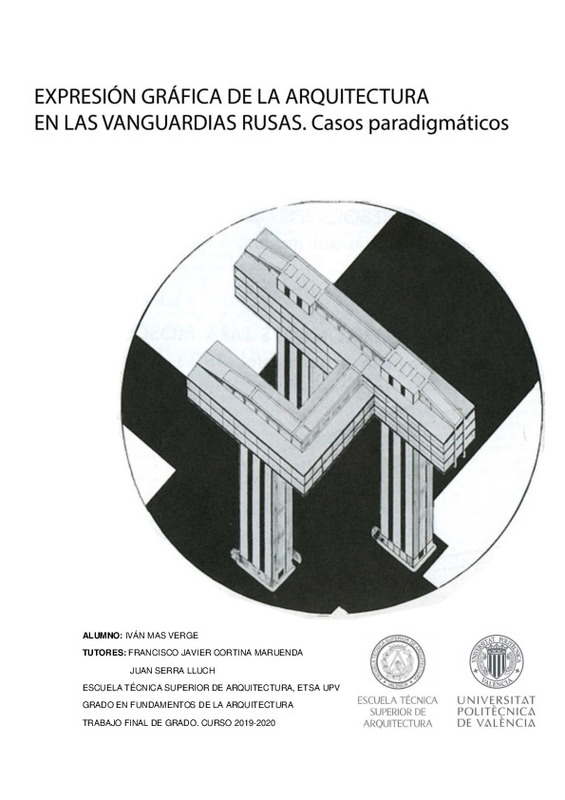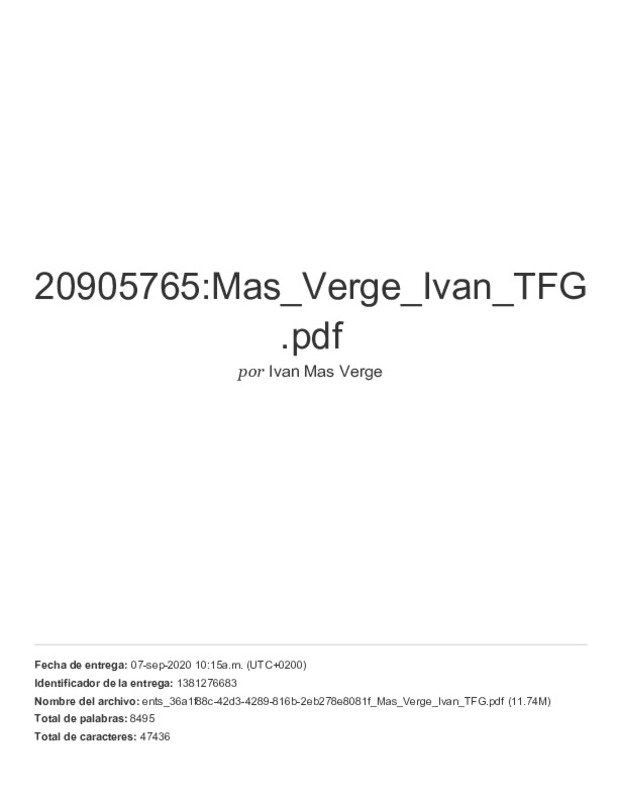JavaScript is disabled for your browser. Some features of this site may not work without it.
Buscar en RiuNet
Listar
Mi cuenta
Estadísticas
Ayuda RiuNet
Admin. UPV
Expresión gráfica de la arquitectura en las vanguardias rusas. Casos paradigmáticos
Mostrar el registro sencillo del ítem
Ficheros en el ítem
| dc.contributor.advisor | Serra Lluch, Juan de Ribera
|
es_ES |
| dc.contributor.advisor | Cortina Maruenda, Francisco Javier
|
es_ES |
| dc.contributor.author | Mas Verge, Iván
|
es_ES |
| dc.date.accessioned | 2020-12-14T13:19:33Z | |
| dc.date.available | 2020-12-14T13:19:33Z | |
| dc.date.created | 2020-09-18 | |
| dc.date.issued | 2020-12-14 | es_ES |
| dc.identifier.uri | http://hdl.handle.net/10251/157115 | |
| dc.description.abstract | [ES] A principios del siglo XX se produjo en Rusia una revolución cultural durante la que surgieron gran número de artistas de todos los campos fruto de la experimentación artística. Este periodo, que se desarrolló de manera paralela a la revolución rusa, sería clave en una época de intensos cambios políticos, sociales y culturales. Sus protagonistas cambiarían a través de su arte e influencia la cultura de su país e incluso del mundo, con manifestaciones que trascendieron las barreras del arte y aspirarían a cambiar la totalidad de los aspectos de la vida de las personas. Este trabajo trata de investigar y analizar la arquitectura y la representación gráfica del movimiento artístico de las vanguardias rusas, poniendo el foco en un caso concreto de estudio. Así, aplicando distintas técnicas y herramientas gráficas reconstruiremos la arquitectura y uno de los paisajes ausentes de El Lissitzky, uno de los arquitectos más representativos de este periodo. La investigación gira en torno a la obra del arquitecto y su contexto. La clave principal, sin embargo, es la arquitectura ausente y la recopilación de información y material gráfico del autor para llevar a cabo una reconstrucción lo más adecuada y precisa posible. Inicialmente, en la primera parte del trabajo, se estudia y organiza cronológicamente la obra del arquitecto, exponiendo sus trabajos y proyectos no construidos, seleccionando uno para su reconstrucción gráfica. En este caso, se ha optado por escoger el Wolkenbügel, su rascacielos horizontal, proyectado para Moscú. Seguidamente, en la segunda parte, explicamos el proceso reconstructivo de la obra y presentamos gráficamente la información y conclusiones obtenidas sobre el desarrollo del trabajo de investigación. | es_ES |
| dc.description.abstract | [EN] At the beginning of the 20th century, a cultural revolution took place in Russia, during which a large number of artists from all fields emerged as a result of artistic experimentation. This period, which developed parallel to the Russian Revolution, would be key in an era of intense political, social and cultural changes. Its protagonists would change through their art and influence the culture of their country and even the world, with manifestations that transcended the barriers of art and aspired to change the totality of aspects of people's lives. This work revolves around investigating and analising the architecture and graphical representation from the Russian avant-garde art movement, focusing on a specific case of study, Thus, applying several techniques and graphical tools, we are going to rebuild the architecture and one of the absent landscapes of El Lissitzky, one of the most recognised architects of that period. The investigation tackles the architect's works and his context. The main point, however, is absent architecture and gathering of information and the author's graphical documentation to make a reconstruction as accurate and precise as possible. On the first part, the architect's works are studied and chronologically organised, presenting his unbuilt projects and choosing one for its graphical reconstruction. In this case, it was decided to use the Wolkenbügel, his horizontal skycraper, projected for Moscow. Next, on the second part, we will explain the reconstructive process of this work and graphically present the information and conclussions obtained during the investigation development. | es_ES |
| dc.format.extent | 80 | es_ES |
| dc.language | Español | es_ES |
| dc.publisher | Universitat Politècnica de València | es_ES |
| dc.rights | Reserva de todos los derechos | es_ES |
| dc.subject | El Lissitzky | es_ES |
| dc.subject | Arquitectura ausente | es_ES |
| dc.subject | Reconstrucción gráfica | es_ES |
| dc.subject | Vanguardias rusas | es_ES |
| dc.subject | Constructivismo | es_ES |
| dc.subject | Wolkenbügel | es_ES |
| dc.subject | Herramientas gráficas | es_ES |
| dc.subject | Absent architecture | es_ES |
| dc.subject | Graphical reconstruction | es_ES |
| dc.subject | Russian avant-garde | es_ES |
| dc.subject | Constructivism | es_ES |
| dc.subject | Graphical tools | es_ES |
| dc.subject.classification | EXPRESION GRAFICA ARQUITECTONICA | es_ES |
| dc.subject.other | Grado en Fundamentos de la Arquitectura-Grau en Fonaments de l'Arquitectura | es_ES |
| dc.title | Expresión gráfica de la arquitectura en las vanguardias rusas. Casos paradigmáticos | es_ES |
| dc.type | Proyecto/Trabajo fin de carrera/grado | es_ES |
| dc.rights.accessRights | Abierto | es_ES |
| dc.description.bibliographicCitation | Mas Verge, I. (2020). Expresión gráfica de la arquitectura en las vanguardias rusas. Casos paradigmáticos. Universitat Politècnica de València. http://hdl.handle.net/10251/157115 | es_ES |
| dc.description.accrualMethod | TFGM | es_ES |
| dc.relation.pasarela | TFGM\101116 | es_ES |
Este ítem aparece en la(s) siguiente(s) colección(ones)
-
ETSA - Trabajos académicos [4688]
Escuela Técnica Superior de Arquitectura







